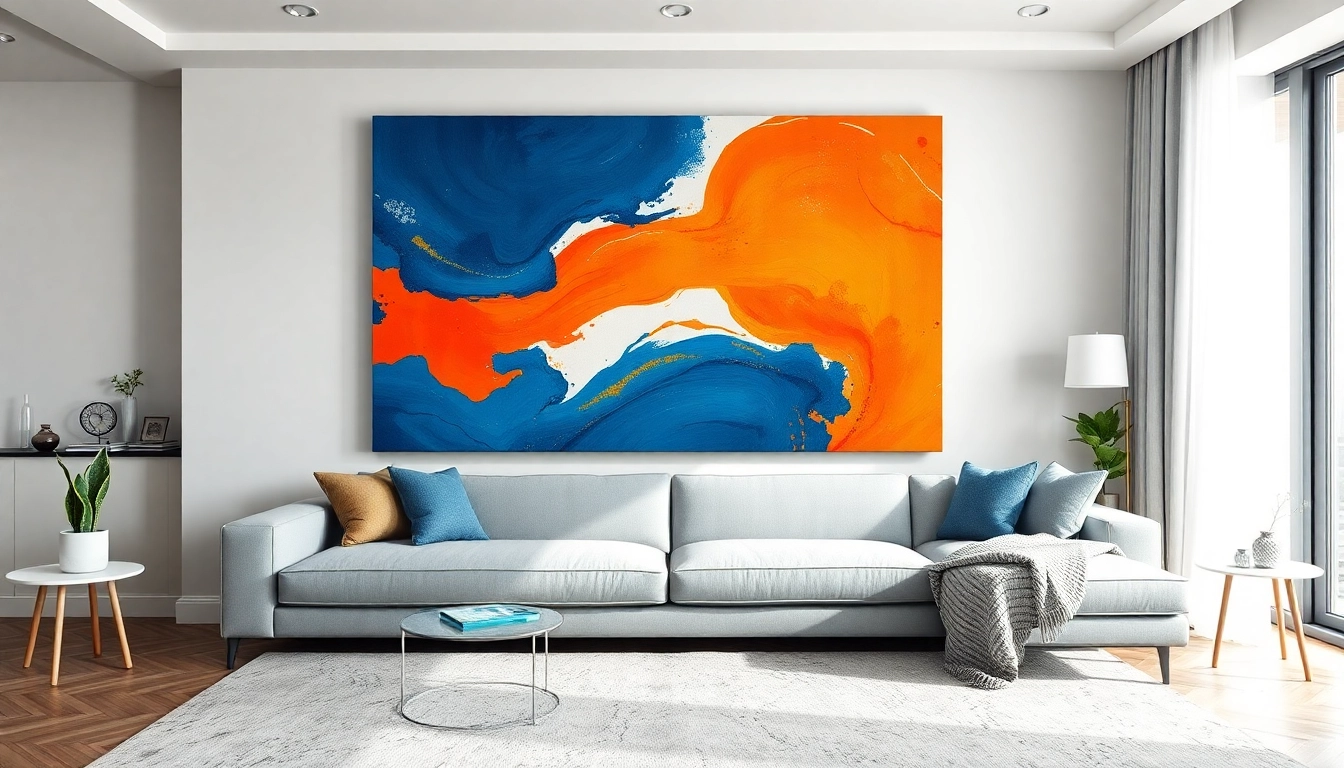Understanding Abstract Paintings Art
Abstract paintings art represents a vibrant and dynamic expression of creativity that transcends traditional artistic boundaries. Unlike representational art, which aims to depict objects and scenes accurately, abstract art focuses on conveying emotions, moods, and experiences through non-representational means. Artists utilize shapes, colors, and forms to create visual compositions that evoke responses independent of a specific narrative. This unique artistic genre encompasses a vast array of substyles and techniques, showcasing the limitless potential of human expression. For those interested in exploring the world of abstract paintings art, it’s essential to grasp its definition, historical context, popular techniques, and styles.
Definition and Characteristics of Abstract Paintings Art
At its core, abstract paintings art is defined by its departure from conventional representations. Rather than depicting real-world objects or beings, abstract art employs a mix of color, form, line, and shape. Key characteristics of this art form include:
- Non-Representational Forms: Abstract art does not seek to represent objects as they are perceived in the real world. Instead, it may utilize forms that are completely unattached to reality.
- Emphasis on Color and Composition: The use of color can evoke emotions and reactions, often more powerfully than literal representations. Composition plays a crucial role in guiding the viewer’s experience.
- Incorporation of Texture: Many abstract pieces employ texture to add depth and interest, making the artwork inviting to explore visually and physically.
- Emotional Resonance: Abstract art is often judged by the emotional impact it has on its viewers. The interpretations may vary, reflecting personal experiences and perceptions.
Historical Context and Evolution
The origins of abstract art can be traced back to the early 20th century when artists began exploring new methods of expression that deviated from the Western art tradition. Sporting influences from various movements, including Impressionism and Expressionism, artists such as Wassily Kandinsky and Kazimir Malevich famously challenged existing conventions. As a result, abstract art evolved through several key periods:
- Early 20th Century: The first true abstract works emerged during this time, marking a significant break from representational art.
- Post-World War II Era: The rise of Abstract Expressionism in the United States signified the peak of abstract art, with artists employing spontaneous and intuitive techniques.
- Contemporary Trends: Today, abstract art continues to evolve, embracing digital media, mixed media, and new technologies while maintaining its core ethos of emotional expression.
Popular Techniques and Styles in Abstract Art
Abstract paintings art comprises a myriad of techniques and styles, each offering a unique perspective and approach. Some notable styles within this genre include:
- Geometric Abstraction: This style focuses on geometric shapes and forms, often employing a limited color palette. Artists such as Piet Mondrian excelled in this realm.
- Color Field Painting: Characterized by large areas of flat color, this technique often emphasizes the emotional power of color itself. Mark Rothko is a prominent figure in this style.
- Action Painting: Central to the Abstract Expressionism movement, this technique involves dynamic brushstrokes and spontaneous application of paint, as seen in the works of Jackson Pollock.
- Minimalism: Stripped down to the essentials, this style seeks to eliminate excess and highlight the beauty of simplicity, often featuring monochromatic palettes.
Choosing the Right Abstract Paintings Art for Your Space
When selecting abstract paintings art for your home or office, it’s essential to consider various factors that can impact the overall aesthetic and emotional tone of your space. Here are some key aspects to consider:
Factors to Consider for Home Decor
To create a harmonious environment, it is vital to consider how the abstract art you select will fit within the existing décor. Factors include:
- Style Compatibility: Ensure that the chosen artwork aligns with the overall style of the room. For instance, a bold, colorful abstract painting might complement modern décor but clash with more traditional interiors.
- Spatial Considerations: Assess the available wall space and the artworks’ sizes before making a purchase. Larger pieces can serve as focal points, while smaller works are well-suited for gallery walls.
- Lighting Conditions: The way light interacts with art can significantly affect its appearance. Consider how natural and artificial light will highlight colors and textures throughout the day.
Color Psychology in Abstract Paintings Art
Colors evoke emotions and can profoundly influence our mood. Understanding color psychology is essential for selecting abstract art that fulfills your desired aesthetic and emotional ambiance:
- Warm Colors: Reds, oranges, and yellows often evoke feelings of warmth, energy, and passion.
- Cool Colors: Blues and greens tend to promote calmness and tranquility, making them ideal for bedrooms or relaxation spaces.
- Neutral Shades: Whites, blacks, and grays can offer a grounding effect and allow other colors in the room to stand out.
Size and Scale: Making an Impact
The size of your abstract paintings art can greatly affect your perception of the space. Consider the following:
- Impactful Statements: Large-scale pieces can serve as dramatic focal points that draw attention and create an emotional response.
- Grouping Smaller Works: Smaller paintings can be displayed in clusters to create visual interest and rhythm within a room.
- Proportional Balance: Ensure that the size of the artwork complements the dimensions of the space. For instance, a tall, narrow painting might work beautifully in a vertically oriented area, such as above a fireplace.
Creating Your Own Abstract Paintings Art
Embracing your creative side and producing your own abstract art can be a fulfilling experience. Here are some essential steps and tips for getting started:
Essential Tools and Materials for Beginners
To embark on your journey into abstract painting, you’ll need a few essential tools and materials:
- Canvas or Paper: Opt for sturdy surfaces that can withstand paint application; canvas is highly recommended for longevity.
- Paints: Choose high-quality acrylics or oils for their vibrant colors and versatility.
- Brushes and Tools: A variety of brushes (flat, round, and filbert) along with palette knives and other tools can help create different textures.
- Protective Clothing: Don an old shirt or apron to keep paint splatters at bay.
Step-by-Step Guide to Creating Abstract Art
Here’s a simple guide to help you produce your own abstract painting:
- Gather Inspiration: Look at existing abstract art to discover styles or techniques that resonate with you. Keep a sketchbook for ideas.
- Select a Color Palette: Choose colors that connect with your emotions or preferred themes; this will guide your creation.
- Begin with Shapes: Start by applying broad shapes or lines, allowing your intuition to take over. There’s no wrong way to express yourself.
- Layer and Experiment: Add layers, textures, and colors gradually, allowing each to dry as needed and exploring contrasts and harmonies.
- Evaluate and Adjust: Step back and assess your work. Make adjustments based on your response to the piece, continuing until you feel satisfied.
Experimenting with Techniques and Styles
Don’t shy away from experimentation! Different styles and techniques can lead to unexpected results and personal expressions:
- Fluid Art: This technique involves pouring paint to create beautiful, marbled effects.
- Collage and Mixed Media: Combine painting with other materials like fabrics, paper, and found objects for dynamic textures.
- Using Alternative Tools: Explore different tools like sponges or even your hands to apply paint for unique effects.
The Impact of Abstract Paintings Art on Emotional Wellbeing
The connection between art and emotional wellbeing is well-documented. Engaging with abstract paintings art can significantly influence mood and creativity. Below, we explore several facets of this relationship.
The Connection Between Art and Mood
Studies have shown that interacting with art positively affects emotional wellbeing. Abstract art, in particular, allows viewers to experience emotions in profound and sometimes unexpected ways:
- Emotional Identification: Viewers often resonate with certain colors and forms, linking them to personal feelings, which can facilitate emotional processing.
- Visual Stimulation: The dynamic elements of abstract art stimulate the brain, encouraging emotional engagement and introspection.
- Calmness and Stress Relief: Relaxing colors and forms can provide a sense of tranquility, aiding in stress reduction and improved focus.
Enhancing Creativity and Focus with Abstract Art
Incorporating abstract art into your environment can boost creativity and concentration for several reasons:
- Encouraging Open-Mindedness: Abstract art challenges viewers to interpret meaning, fostering open-mindedness and innovative thinking.
- Stimulating Discussions: Displaying abstract paintings often sparks conversations, promoting brainstorming and collaborative thinking.
- Creating an Inspiring Environment: Surrounding oneself with inspiring art can lead to enhanced motivation and improved task performance.
Case Studies: Transformative Experiences Through Art
There are numerous anecdotal accounts that highlight the transformative power of art. From community art projects to personal experiences, individuals have reported significant improvements in their emotional resilience and overall wellbeing:
- Community Engagement: Programs that bring art into underserved communities demonstrate reduced stress and improved community relationships.
- Therapeutic Practices: Art therapy has proven exceptionally beneficial for individuals grappling with mental health challenges, providing an outlet for expression and healing.
- Personal Transformation: Many individuals report finding solace and inspiration through the act of creating or engaging with abstract art, which helps them process life challenges.
Where to Find Quality Abstract Paintings Art
In today’s digital age, finding quality abstract paintings art is more accessible than ever. Here are some insights on how to navigate the art market:
Online Marketplaces vs. Local Art Galleries
When searching for abstract art, buyers can choose between online platforms and local galleries, each presenting its advantages:
- Online Marketplaces: These platforms provide a vast selection of pieces from emerging and established artists. The convenience of browsing from home, coupled with the ability to compare prices, makes online shopping appealing.
- Local Art Galleries: Visiting galleries offers the benefit of seeing artwork in person, allowing potential buyers to experience textures and colors firsthand. Local galleries often foster community connections, enriching the art-buying experience.
Understanding Art Valuation and Investment
If you’re considering investing in abstract paintings art, understanding valuation is crucial:
- Artist Reputation: The artist’s history, accomplishments, and current market interest can influence valuation.
- Authenticity and Documentation: Ensure that the artwork comes with proper documentation to verify its authenticity and provenance.
- Market Trends: Stay informed about market trends and buyer interest in specific artists or styles, as this can influence long-term value.
Connecting with Emerging Abstract Artists
Supporting emerging artists can be both fulfilling and economically advantageous:
- Local Exhibitions: Keep an eye out for local exhibitions showcasing up-and-coming artists, providing an invaluable opportunity to acquire unique pieces.
- Online Portfolios: Many emerging artists maintain online portfolios or social media pages, making it easier to discover unique talent and purchase works directly.
- Commissioned Artwork: Engaging with artists for commissioned work allows for personalized pieces that resonate deeply with your artistic vision.



